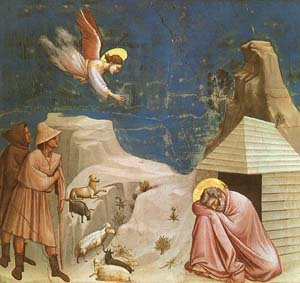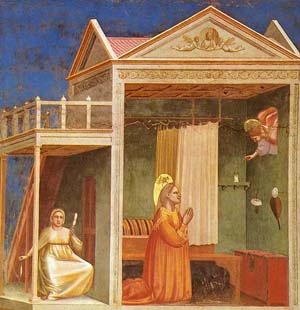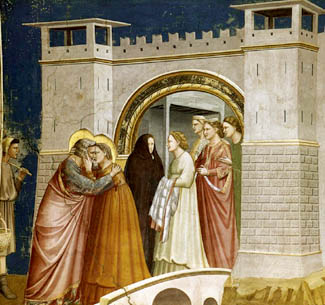 |
The Saint of the Day
St. Joachim – August 16
Prof. Plinio Corrêa de Oliveira
Biographical selection:
The details about the father of Our Lady were given to us by an apocryphal book, The Gospel of James. His name, Joachim, means preparation for the Lord, and Anne means grace.

The rejection of St. Joachim's sacrifice - Giotto
|
A long tradition tells us that Ss. Joachim and Anne were wealthy, having many flocks and herds like the first Patriarchs. But the Lord did not give them the greatest richness they desired, a child, since Anne was barren.
One day Joachim went to the Temple to present his sacrifice, but his offers were rejected with scorn. Much ashamed and not knowing the will of God, the Patriarch fled to the mountains, without returning to the house of his wife. He began to fast, making this resolution: “I will not take any food until the Lord looks at me with mercy. My prayer will be my fast.”
In the meantime, St. Anne wept at the loss of her husband and her barrenness. And while she wept in her garden and her husband prayed in the mountain, their prayers were heard. An angel of the Lord appeared to both of them and bade them meet at the Golden Gate. The angel told them that Anne would give birth to a daughter, who should be called Mary. She would become the mother of Jesus, “Son of the Most High.”
Thus, Anne would say: “Now, I know that the Lord hast greatly blessed me because I, who was a widow, am no longer one, and I, who was barren, am no longer so.” And the descendants of Joachim would be mighty and blessed in Heaven and upon earth.
Comments of Prof. Plinio:
This selection based on Dom Gueranger presents several points worthy of comment.

God sends an Angel to St. Joachim in the mountains, above, and to St. Anne in her home

|
The first is to see the beautiful custom the ancient Eastern peoples had of giving a symbolic name to each person. That custom influenced Catholic Tradition. The parents of Our Lady had symbolic names in such a way that the combination of their names defined what Our Lady would be. Joachim means preparation for the Lord, Anne signifies grace. This is precisely what Our Lady was, a preparation for the coming of the Incarnate God by means of a woman who was full of grace. She was the one who bore Our Lord and earned all the graces. The names of Joachim and Anne explained to them and to us what Our Lady would be. This is the precious world of symbols of the ancient world, so different from our tasteless modern West.
Second, St. Joachim raised the scorn of the priests at the Temple because at that time the Jews thought that barren couples did not receive the blessing of the Lord. The glory for a Jew was to be an ancestor of the Messiah, the One awaited by the nations. The barren couple, therefore, would be denied such a glory. Other sources of tradition say that St. Joachim and St. Anne faced this scorn not just this one time, but many times. It was a constant burden they had to bear. In this case, it was still more afflictive because both were reaching old age and still they did not have a child. Thus, St. Joachim prayed to God asking Him to have mercy on them in their despised situation. After the prayer of both saints, God sent them a daughter. And what an exceptional daughter!
Third, St. Anne was afflicted because St. Joachim went away ashamed without returning to their home, which made her think that he had died. He went in a great depression, I would say.
The prayer of St. Joachim was very strong and beautiful. It affirmed his certainty of receiving what he was requesting. He made violence against Heaven to obtain what he desired. He resolved to not eat anything until God would hear his prayer. I think it was St. Catherine of Sienna who once said before the Tabernacle: “I will not leave from this place until Thou dost extend Thy hand to me.” And Our Lord had the mercy to open the door of the Tabernacle and take her hand in His. This is how God responds to the confidence of the Saints. St. Joachim had this kind of confidence. He received what he required from God.

The meeting at the Golden Gate
|
Fourth, the prayer and attitude of St. Anne was also very beautiful. God allowed them to go through that trial until they had reached the extreme of suffering. She suffered not only from being barren, but now had the added affliction of becoming a widow overnight. She thought she had lost her most exemplary and noble spouse to whom she had a great esteem. For her this represented the apex of the suffering. When the sorrow had reached this apex, then the grace, the liberation came.
What was that liberation? An angel came to tell her that St. Joachim had not died, and that she should go to meet him at the Golden Gate that stood before the Temple, and that she would conceive a child. She would receive the grace to conceive the child – Our Lady – who would be the road to all graces.
From this trial in the life of both saints, we can find a lesson in confidence. When everything seems lost, when nothing seems to make any sense, when the action of Divine Providence toward us seem inexplicable, this is the moment when we should trust with the most confidence, because we are drawing near the moment when every explanation will be given.
Blessed are those whom God sets on the roads of the inexplicable, because they will receive the most excellent explanations.
Here we close, then, with our prayer to St. Joachim, St. Anne and Our Lady of the Assumption, that they give us a confidence that resists every trial, that can bear the most inexplicable contradictions, and that affirms itself amid the greatest sorrows.


  | | Prof. Plinio Corrêa de Oliveira | |
The Saint of the Day features highlights from the lives of saints based on comments made by the late Prof. Plinio Corrêa de Oliveira. Following the example of St. John Bosco who used to make similar talks for the boys of his College, each evening it was Prof. Plinio’s custom to make a short commentary on the lives of the next day’s saint in a meeting for youth in order to encourage them in the practice of virtue and love for the Catholic Church. TIA thought that its readers could profit from these valuable commentaries.
The texts of both the biographical data and the comments come from personal notes taken by Atila S. Guimarães from 1964 to 1995. Given the fact that the source is a personal notebook, it is possible that at times the biographic notes transcribed here will not rigorously follow the original text read by Prof. Plinio. The commentaries have also been adapted and translated for TIA’s site.
|
Saint of the Day | Home | Books | CDs | Search | Contact Us | Donate

© 2002- Tradition in Action, Inc. All Rights Reserved
|
 |

|